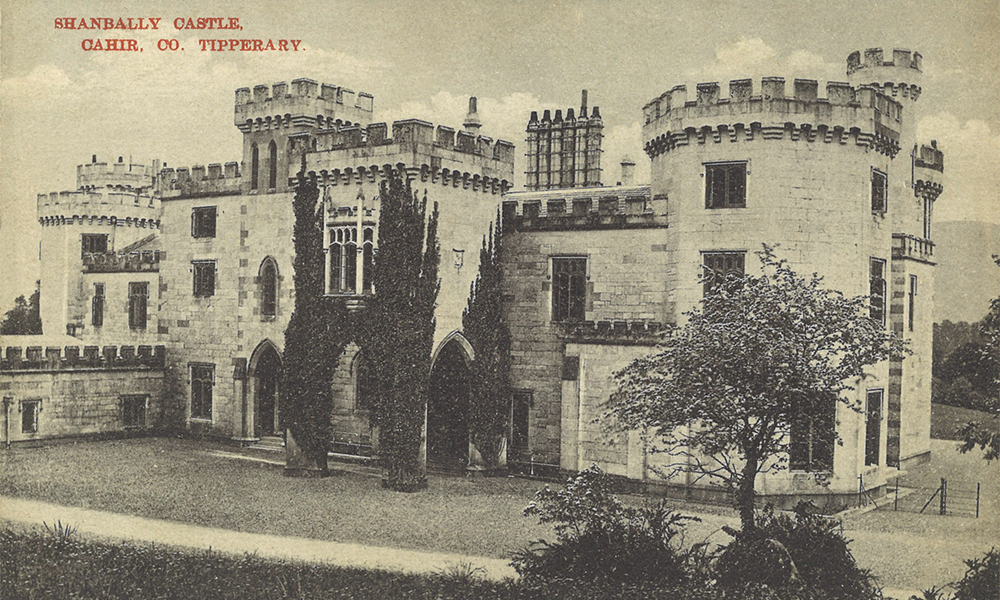by Liam Dolphin, BA History Student
Shanbally Castle was a magnificent country house located near Clogheen in County Tipperary, built for the 1st Viscount Lismore, Cornelius O’Callaghan (1775 – 1857). Having risen in 1806 from being a Baron, work on the house began in 1810, after Lismore commissioned the renowned Regency period architect John Nash to draw up the design. The house, completed around 1812, was built in a Gothic Revival style, with turrets and towers dotting the main building. 1

A hardback ledger, 1811-1813 (P43/103)
A ledger containing financial accounts pertaining to expenditure at Shanbally Castle can be found today in the Timothy Looney Papers (P43) at the University of Limerick. This modestly sized, carefully handwritten and leather-bound item is one of the few documents from the castle to outlive it. In the 1950s, the Irish Land Commission acquired the house and sought unsuccessfully to find a buyer. Deeming it to be in such a state of disrepair and lacking the funds to restore it or a buyer to purchase it, they decided to go ahead with demolition in 1957.
Inside the house, many of the estate records still existed, and almost all of the internal recorded history of the estate was destined to be lost alongside the building. Luckily, due to the actions of one person, local historian Timothy Looney, two trunks of records were recovered from the attic of the house shortly before it was destroyed, including this ledger.
In the grand scheme of the estate, this ledger is a normal everyday account book, no more important than the ones that would come before or after it. Its primary purpose was to ensure that the finances, particularly expenditures, were being correctly tracked and that there were no irregularities with how money was being spent in the house or the estate. This ensured that the finances of the house were in order and that there was no mismanagement in the running of the Estate.
This particular ledger tracked expenditure in the years 1811, 1812 and 1813. It covered many different aspects of how money was spent in the estate. It primarily covers the expenditure on the farms of the estate including mentioning specific farms, such as the Mountain Farm, the Ballyboy Farm, Scartanny Farm and Nowells Farm. In the case of the first two, it also outlines the cost of animals such as cattle and sheep for the farms.

The ledger also outlines expenditure on other parts of the estate, including the general cost of corn and hay for the entire estate, the cost of improvements to the estate, and miscellaneous expenditures titled ‘Sundries’.
The ‘New Mansion’
Perhaps one of the most interesting sections of the ledger is that concerned with the cost of the ‘New Mansion’, Shanbally Castle, which was begun in 1810 and completed in 1812, the expense of which fell primarily within the period that this item covers. It shows that the house, as a whole, cost £4,389 6s. 4½d. While this may not sound like a lot of money today, it is important to note the difference in the worth of £1 in 1813.
In 1810, £1 was the equivalent of about £46.53 in 2017. By using these numbers, we can calculate the equivalent value of the money spent on the house in 2017, which would be about £204,213.84, or €234,521.34, a much higher amount compared to what may initially seem to be a paltry amount to spend on a house of its size at first glance.

The final balance sheet of the ledger displays the overall expenditure across all sections of this ledger, coming out at £16,638 14s 1d. Like the total figure given for the building of the ‘new house’, £16,638 may seem like a small amount, but when calculated to a ‘modern’ equivalent from 2017, it totals about £774,119.04 or €889,006.52. 2
This Regency-era ledger and the other archival items saved by Timothy Looney are important records of how these houses operated and what their owners and occupiers spent money on throughout the estate. It also gives us an insight into the expansive records that were kept by these households in order to ensure money was not being mismanaged or embezzled. We owe much to Timothy Looney for, without his decision to save these important documents, we would have lost this ledger and many other important records and documentation relating to this once great house.
- John P. Morrissey, ‘Shanbally Castle: A lost treasure’ (2022) (https://www.johnpmorrissey.com/post/shanbally/ [↩]
- The National Archives, UK, Currency converter: 1270–2017 (2018) (https://www.nationalarchives.gov.uk/currency-converter/) (20 Oct. 2022) [↩]




You must be logged in to post a comment.